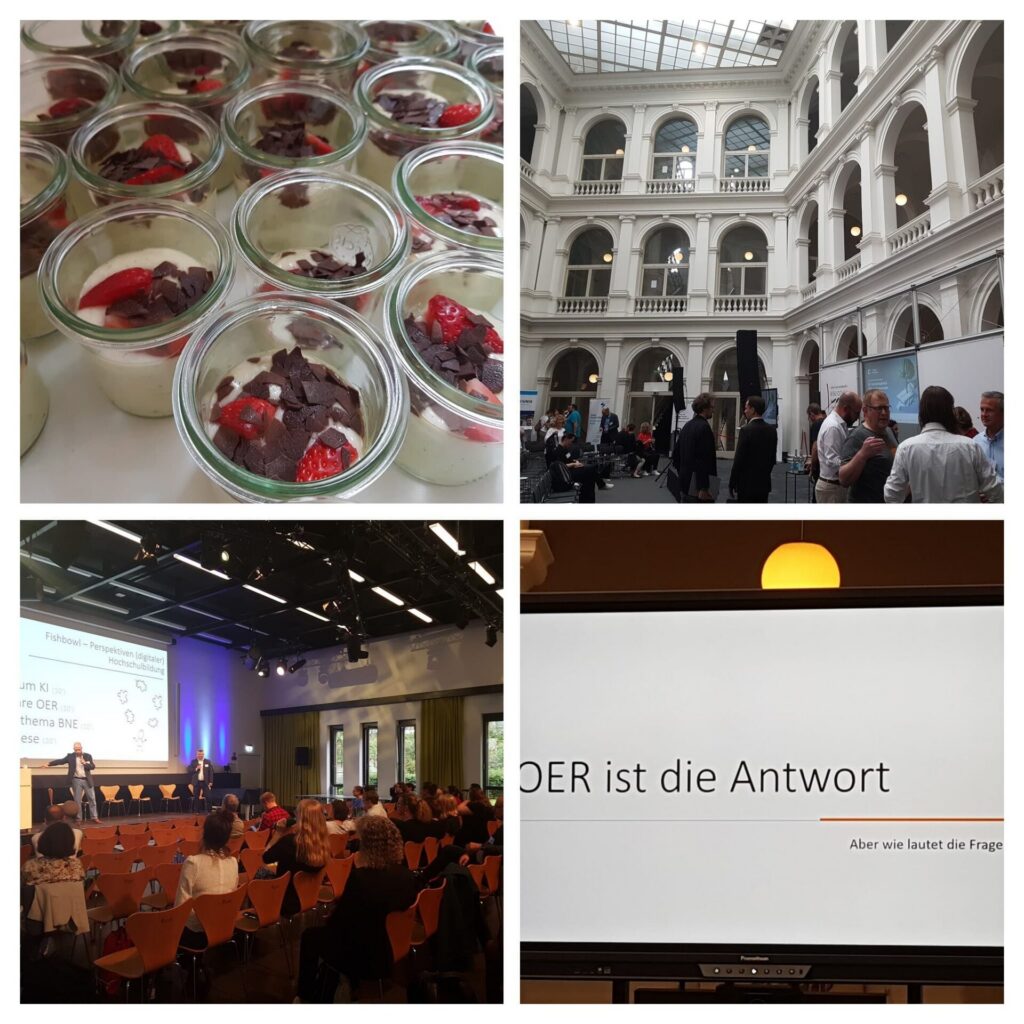Let’s turn the heat up to three right away!
Under this motto, Prof. Dr. Kerstin Mayrberger put forward the following thesis in her lecture: “OEP as a collective practice currently stands for higher education in (post)digitality — and is constantly developing in a complex environment”. To this end, she first addressed the range of OEP definitions — from broad to narrow — and then explained what is needed for the shift towards a culture of sharing: Participation, relationships, trust, transparency, resilience, equity, commons and sustainability. She emphasized that the focus of OEP should not be on the materials alone, but rather on the fundamental attitude towards openness with the associated values and principles.

She cited trust as an example: In the old world, quality assurance is very important as a prerequisite for OEP. For example, OER undergo a review process after creation. In the new world, trust is placed in the fact that the actors enter the review process right at the beginning of the OER creation process by seeking advice from their environment and engaging in a critical exchange with the community.
The implementation of OEP as a collective practice could start with an applied concept in the universities and then be transferred to other concepts. However, the prevailing approach of restructuring 90% according to the old procedure and only 10% according to openness principles would not apply. Once everything has been analyzed under the OEP lens, the result should be 50/50. Mayrberger’s pragmatic vision would be for ten courageous institutions from different areas of higher education to lead the way with this restructuring process and demonstrate consistent OEP so that others can easily follow suit.
OER is the answer — but what is the question?
In his presentation, Prof. Dr. Daniel Otto took us on a journey through time “20 years of OER in Germany” and presented various studies on the topic of OER. While the initial focus was often on the attitudes of OER activists (result: driven by emotions), the obstacles to the use of OER were later more frequently addressed. Based on a meta-study of 272 published studies, Otto showed that less research has been carried out into the strategies of universities and incentive systems for OER. But do we even have an eye on the reality of OER activists or is there a lot going on below the radar, namely in collegial exchanges at schools and universities — the dark reuse hypothesis?
Looking back on 20 years of OER, it is at least encouraging that the infrastructure, such as the state portals, has been expanded. Otto’s conclusion is that OER started as an idealistic bottom-up movement and should now very realistically be adopted more by universities as a top-down topic. However, this certainly has a chance, as some long-standing OER enthusiasts now have a foot in the door through certain positions in the universities.
After the two presentations, four OER activists entered the OER slam ring. The procedure and in particular the strict time limit of eight minutes per presentation prevented one or two of them from getting a final punchline — but the courage to take on this new format was rewarded by the audience for all of them. Martin Schultze was able to take the prize money of 500 euros back to Frankfurt’s Goethe University.
See you in 2050
The premises of the Department of Design at HAW Hamburg were highly inspiring for the barcamp on Friday. Some topics had already been submitted in advance, but as is usual at a barcamp, further ideas were spontaneously added during session planning. There was a wide range of sessions, such as the visibility of OER communities at universities, a roadmap for digital higher education in 2050 and the legal implications of AI-generated texts and images in OER.
As we are working on different aspects of the complex topic of open education in the twillo joint project, we contributed two sessions. Klaus Wannemacher presented the study on OER-promoting infrastructures. According to the study, there are particular challenges with regard to better networking of existing OER portals and tools as well as the establishment and use of a standard vocabulary for teaching and learning materials.
In an extensive discussion round, very different assessments and suggestions emerged in this session: Even recent approaches in the field of metadata for open educational materials hardly stood out due to a pronounced didactic focus. OER portals should facilitate the indexing of OER through appropriate assistance functions. OER portals should also consider entering into a stronger dialog with specialist circles and professional associations. It could also be helpful to actively draw the attention of academics to subject-related OER.
Axel Klinger’s session was a little more technical. Based on the key question of what we can learn from open source developments, open collaboration on educational materials was discussed. With the collection in OERSI, considerations about suitable working environments and particularly open formats (according to the FAIR Data Principles) became elementary. Common requirements in the development of open source software and open educational materials are freely available and openly licensed sources and results, the coordinated joint editing of files, as little dependence as possible on commercial products and transparency about changes and decisions in further development. GitHub/GitLab and OERSI already offer a global solution for the creation, joint further development and open use of open and attractive educational materials in all areas of teaching. With the right templates and instructions, the effort is manageable and the reach is great.
We would like to thank the organizers and all participants for two wonderful days and look forward to the next opportunity for fruitful exchanges and exciting encounters.